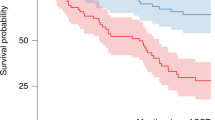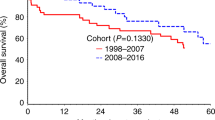Summary:
In this retrospective single-centre study, 96 consecutive myeloma patients were treated with melphalan 200 mg/m2 with blood stem cell support as first-line therapy. Their mean age was 55 (38–65) years. The impact of renal function on stem cell collection yield, engraftment, transplantation-related toxicity and overall survival was studied. Glomerular filtration rate (GFR) was evaluated by iohexol clearance, a median 32 days before high-dose administration. Chronic renal failure (GFR <60 ml/min) was present in 19 patients, with severe failure (GFR <30 ml/min) in five patients, including one patient on haemodialysis. No relationship between GFR and stem cell collection yield or engraftment was observed, nor was the incidence of neutropenic fever or infectious complications related to GFR. Patients with subnormal renal function, however, were more often affected by severe mucositis. In addition, the two patients with severe GI bleeding, the two pneumonia patients who needed ventilator support and the only therapy-related death were noted in the five patients with severe renal failure. Lower iohexol clearance at the time of high-dose administration was found to have a poor impact on survival. A reduction of melphalan dose in patients with severe renal failure, here defined as iohexol clerarance <30 ml/min, is suggested.
This is a preview of subscription content, access via your institution
Access options
Subscribe to this journal
Receive 12 print issues and online access
$259.00 per year
only $21.58 per issue
Buy this article
- Purchase on Springer Link
- Instant access to full article PDF
Prices may be subject to local taxes which are calculated during checkout

Similar content being viewed by others
References
Attal M, Harousseau JL, Stoppa AM et al. A prospective, randomized trial of autologous bone marrow transplantation and chemotherapy in multiple myeloma. Intergroupe Francais du Myelome. N Engl J Med 1996; 335: 91–97.
Fermand JP, Ravaud P, Chevret S et al. High-dose therapy and autologous peripheral blood stem cell transplantation in multiple myeloma: up-front or rescue treatment? Results of a multi-center sequential randomized clinical trial. Blood 1998; 92: 3131–3136.
Lenhoff S, Hjorth M, Holmberg E et al. Impact on survival of high-dose therapy with autologous stem cell support in patients younger than 60 years with newly diagnosed multiple myeloma: a population-based study. Blood 2000; 95: 7–11.
Alexanian R, Barlogie B, Dixon D . Renal failure in multiple myeloma: pathogenesis and prognostic implications. Arch Intern Med 1990; 150: 1693–1695.
Knudsen LM, Hippe E, Hjorth M et al. Renal function in newly diagnosed multiple myeloma. Eur J Haematol 1994; 53: 207–212.
Iggo N, Palmer ABD, Severn A et al. Chronic dialysis in patients with multiple myeloma and renal failure: a worthwhile treatment. Q J Med 1989; 270: 903–910.
Innes A, Cuthbert RJ, Russell NH et al. Intensive treatment of renal failure in patients with multiple myeloma. Clin Lab Haematol 1994; 16: 149–156.
Johnson WJ, Kyle RA, Pineda AA et al. Treatment of renal failure associated with multiple myeloma. Plasmapheresis, hemodialysis and chemotherapy. Arch Intern Med 1990; 150: 863–869.
Knudsen LM, Hjorth M, Hippe E . Renal failure in multiple myeloma: reversibility and impact on the prognosis. Eur J Haematol 2000; 65: 175–181.
Torra R, Bladé J, Cases A, Lopez-Pedret J . Patients with multiple myeloma requiring long-term dialysis: presenting features, response to therapy, and outcome in a series of 20 cases. Br J Haematol 1995; 91: 854–859.
Badros A, Barlogie B, Siegel E et al. Results of autologous stem cell transplant in multiple myeloma patients with renal failure. Br J Haematol 2001; 114: 822–829.
Ballester OF, Tummala R, Janssen WE et al. High-dose chemotherapy and autologous peripheral blood stem cell transplantation in patients with multiple myeloma and renal insufficiency. Bone Marrow Transplant 1997; 20: 653–656.
San Miguel JF, Lahuerta JJ, Garcia-Sanz R et al. Are myeloma patients with renal failure candidates for autologous stem cell transplantation? Hematol J 2000; 1: 28–36.
Sirohi B, Powles R, Kulkarni S et al. Glomerular filtration rate prior to high-dose melphalan 200 mg/m2 as a surrogate marker of outcome in patients with myeloma. Br J Cancer 2001; 85: 325–332.
Tosi P, Zamagni E, Ronconi S et al. Safety of autologous hematopoietic stem cell transplantation in patients with multiple myeloma and chronic renal failure. Leukemia 2000; 14: 1310–1313.
Tricot G, Alberts DS, Johnson C et al. Safety of autotransplants with high-dose melphalan in renal failure: a pharmacokinetic and toxicity study. Clin Cancer Res 1996; 2: 947–952.
Lee C-K, Zangari M, Barlogie B et al. Myeloma. Dialysis-dependent renal failure in patients with myeloma can be reversed by high-dose myeloablative therapy and autotransplant. Bone Marrow Transplant 2004; 33: 823–828.
Child A, Morgan G, Davies F et al. High-dose chemotherapy with hematopoietic stem-cell rescue for multiple myeloma. N Engl J Med 2003; 348: 1875–1883.
Lenhoff S, Hjorth M, Westin J et al. Impact of age on survival after high-dose therapy with autologous stem cell support in newly diagnosed multiple myeloma: a population-based study. (submitted for publication).
Cockcroft DW, Gault MH . Prediction of creatinine clearance from serum creatinine. Nephron 1976; 16: 31–41.
National Kidney Foundation. K/DOQI clinical practice guidelines for chronic kidney disease: evaluation, classification and stratification. Am J Kidney Dis 2002; 39 (Suppl. 1): S1–S266.
Knudsen LM, Nielsen B, Gimsing P, Geisler C . Autolgous stem cell transplantation in multiple myeloma with renal failure. Blood 2003; 102: 985a (abstract 3667).
Author information
Authors and Affiliations
Corresponding author
Rights and permissions
About this article
Cite this article
Carlson, K. Melphalan 200 mg/m2 with blood stem cell support as first-line myeloma therapy: impact of glomerular filtration rate on engraftment, transplantation-related toxicity and survival. Bone Marrow Transplant 35, 985–990 (2005). https://doi.org/10.1038/sj.bmt.1704948
Received:
Accepted:
Published:
Issue Date:
DOI: https://doi.org/10.1038/sj.bmt.1704948
Keywords
This article is cited by
-
Autologous stem cell transplantation for multiple myeloma patients with chronic kidney disease: a safe and effective option
Bone Marrow Transplantation (2022)
-
Pretransplant hemoglobin and creatinine clearance correlate with treatment-free survival after autologous stem cell transplantation for multiple myeloma
Bone Marrow Transplantation (2019)
-
Lower glomerular filtration rate predicts increased hepatic and mucosal toxicity in myeloma patients treated with high-dose melphalan
International Journal of Hematology (2018)
-
New photobiomodulation protocol prevents oral mucositis in hematopoietic stem cell transplantation recipients—a retrospective study
Lasers in Medical Science (2017)
-
Melphalan 200 mg/m2 in patients with renal impairment is associated with increased short-term toxicity but improved response and longer treatment-free survival
Bone Marrow Transplantation (2016)



